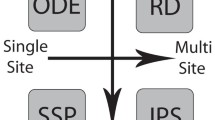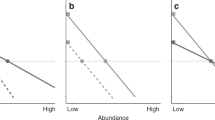Abstract
Populations often exhibit abrupt changes in abundance associated with a smooth, continuous change in some component of their environment, with the abruptness usually attributed to inter-specific interactions or physical extremes. This paper presents a spatially explicit single-species population model in which intra-specific interactions alone are responsible for such an abrupt change. The essential mechanism involves cooperation in both colonization (through enhanced recruitment near other individuals) and mortality (protection through a “safety-in-numbers” interaction). Large fluctuations in population density would likely be observable near the transition region.
Similar content being viewed by others
References
Bertness, M. D. and E. Grosholz, 1985. Population dynamics of the ribbed mussel,Geukensia demissa: the costs and benefits of an aggregated distribution.Oecologia 67, 192–204.
Connell, J. H., 1975. Some mechanisms producing structure in natural communities: a model and evidence from field experiments. InEcology and Evolution of Communities, M. L. Cody and J. Diamond (Eds), pp. 460–490. Cambridge MA: Belknap Press.
Dayton P. K. 1971. Competition, disturbance, and community organisation: the provision and subsequent utilisation of space in a rocky intertidal community.Ecol. Monographs,41, 351–389.
Denny, M. W. 1987. Lift as a mechanism of patch initiation in mussel beds.Exp. Marine Biol. Ecol. 113, 231–245.
Denny, M. W., T. L. Daniel, and M. A. R. Koehl. 1985. Mechanical limits to size in wave-swept organisms.Ecol. Monographs 55, 69–102.
de Roos, A. M., E. McCauley, and W. G. Wilson, 1991. Mobility versus density-limited predator-prey dynamics on different spatial scales.Proc. Roy. Soc. London Ser. B 246, 117–122.
Durrett R. 1988.Lecture Notes on Particle Systems and Percolation. Pacific Grove, CA: Wadsworth & Brooks/Cole Advanced Book & Software.
Efford, I. E. 1970. Recruitment to sedentary marine populations as exemplified by the sand crab,Emerita analoga (Decapoda, Hippidae).Crustaceana 18, 293–308.
Gurney, W. S. C., and R. M. Nisbet. 1978a Predator-prey fluctuations in patchy environments.Amer. Naturalist 112, 1075–1090.
Gurney, W. S. C. and R. M. Nisbet. 1978b. Single species population fluctuations in patchy environments.J. Animal Ecol. 47, 85–102.
Haken, H. 1983.Synergetics: An Introduction. Nonequilibrium Phase Transitions and Self-Organization in Physics, Chemistry, and Biology, 3rd rev. ed. Berlin: Springer-Verlag.
Harada, Y. and Y. Iwasa. 1994. Lattice population dynamics for plants with dispersing seeds and vegetative propagation.Res. Population Ecol.,36, 237–249.
Hastings, A. and K. Higgins, 1994. Persistence of transients in spatially structured ecological models.Science 263, 1133–1136.
Huang, K. 1987.Statistical Mechanics, New York: Wiley.
Hughes, T. P. 1994. Catastrophes phase shifts and large-scale degradation of a Caribbean coral reef.Science 265, 1547–1551.
Keddy, P. A. 1985. Wave disturbances in lakeshores and the within-lake distribution of Ontario's Atlantic coastal plain flora.Canadian J. Botany 63, 656–660.
Klein, M. J. 1974. Historical origins of the van der Waals equation. InVan der Waals Centennial Conference on Statistical Mechanics, C. Prins (Ed.). Amsterdam: North-Holland.
Kooijman, S. A. L. M. 1993.Dynamic Energy Budgets in Biological Systems: Theory and Applications in Ecotoxicology. Cambridge: Cambridge University Press.
Kooijman, S. A. L. M. and J. J. M. Bedaux. 1995. Analysis of toxicity tests onDaphnia survival and reproduction. Preprint.
Levin, S. A. and R. T. Paine. 1974. Disturbance, patch formation and community structure.Proc. Natl. Acad. Sci. U.S.A. 71, 2744–2747.
Lewis, J. R. 1964.The Ecology of Rocky Shores. London: English Universities Press.
Lubchencko, J. and B. A. Menge. 1978. Community development and persistence in a low rocky intertidal community.Ecol. Monographs 59 67–94.
Ludwig, D., D. D. Jones, and C. S. Holling. 1978. Qualitative analysis of insect outbreak systems: the spruce budworm and forest.J. Animal Ecol. 47, 315–332.
Marsh, C. P., 1986. Rocky intertidal community organisation: the impact of avian predators on mussel recruitment.Ecology 67, 771–786.
Matsuda, H., N. Ogita, A. Sasaki, and K. Sato. 1992. Statistical mechanics of population.Prog. Theor. Phys. 88, 1035–1049.
Maxwell, J. C. 1875. On the dynamic evidence of the molecular composition of bodies.Nature 11, 357–374.
May, R. M. 1977. Thresholds and breakpoints in ecosystems with a multiplicity of stable states.Nature 269, 471–477.
McCauley, E., W. G. Wilson, and A. M. de Roos. 1993 Dynamics of agen-structured and spatially structured predator-prey interactions individual-based models and population-level formulations.Amer. Naturatlist 142, 412–442.
Menge, B. A. 1976. Organization of the New England rocky intertidal community: role of predation competition, and environmental heterogeneity.Ecol. Monographs,46, 355–393.
Murray, J. D. 1989.Mathematical Biology. Heidelberg: Springer-Verlag.
Nielsen, C. 1987. Distribution of stream-edge vegetation along a gradient of current velocity.J. Ecol. 75, 513–522.
Nisbet, R. M. and W. S. C. Gurney. 1982.Modeling Fluctuating Populations. Chichester: Wiley.
Nisbet, R. M. and L. Onyiah. 1994. Population dynamic consequences of competition within and between age-classes.J. Math. Biol.,32, 329–344.
Nisbet, R. M., A. H. Ross, and A. J. Brooks. 1995. Empirically based dynamic energy budget models: theory and an application to ecotoxicology.Nonlinear World, in press.
Noble, I. 1993. A model of the responses of ecotones to climate change.Ecol. Appl. 3, 396–403.
Noy-Meir, I. 1975. Stability of grazing systems: an application of predator-prey graphs.J. Ecol. 63, 459–481.
Paine, R. T. and S. A. Levin. 1981. Intertidal landscapes: disturbance and the dynamics of pattern.Ecol. Monographs 51, 145–178.
Robles, C. 1987. Predator foraging characteristics and prey population structure on a sheltered shore.Ecology 68, 1502–1514.
Robles, C. 1994. Changing recruitment rates in constant species assemblages: implications for predation theory in intertidal communities. Unpublished.
Roughgarden, J., S. D. Gaines, and H. P. Possingham. 1988. Recruitment dynamics in complex life cycles.Science 241, 1460–1466.
Sato, K. and Y. Iwasa. 1993. Modeling of wave regeneration in subalpine Abies forests: population dynamics with spatial structure.Ecology 74, 1538–1550.
Schlögl, F. 1972. Chemical reaction models for non-equilibrium phase transitions.Z. Phys. 253, 147–161.
Slatyer, R. O. and I. Noble. 1992. InLandscape Boundaries: Consequences for Biotic Diversity and Ecological Flows, A. J. Hansen and F. di Castri, (Eds), pp. 346–359. New York: Springer-Verlag.
Wilson, W. G. and W. G. Laidlaw, 1992. Microscopic-based fluid flow invasion simulations.J. Statist. Phys. 66, 1165–1176.
Wilson, W. G. and R. M. Nisbet. 1996. Cooperation and competition along smooth environmmental gradients. Unpublished.
Wilson, W. G. and C. A. Vause. 1989. Ferromagneticq=4,5 Potts models on the two-dimensional Penrose and square lattices.Phys. Rev. B 39 4651.
Wolfram, S. 1983. Statistical mechanics of cellular automata,Rev. Mod. Phys. 55, 601–644.
Author information
Authors and Affiliations
Rights and permissions
About this article
Cite this article
Wilson, W.G., Nisbet, R.M., Ross, A.H. et al. Abrupt population changes along smooth environmental gradients. Bltn Mathcal Biology 58, 907–922 (1996). https://doi.org/10.1007/BF02459489
Received:
Accepted:
Issue Date:
DOI: https://doi.org/10.1007/BF02459489




